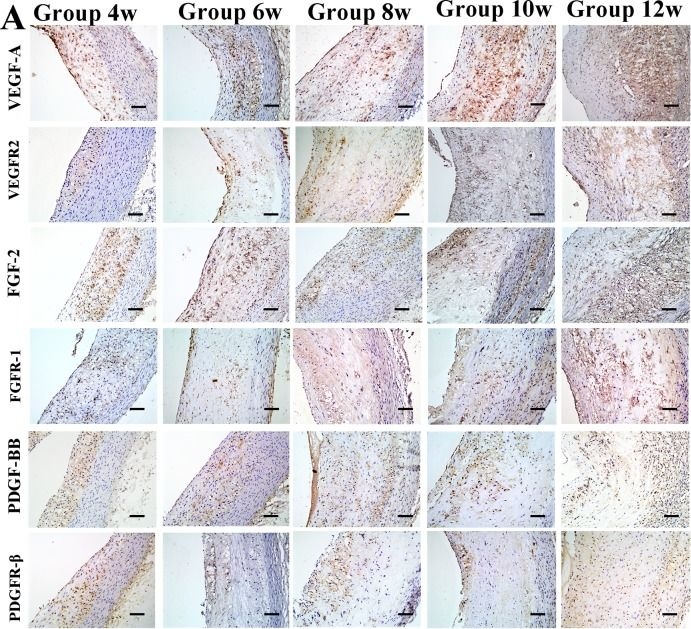Anti-FGFR1 [Clone M2F12]
Anti-FGFR1 [Clone M2F12]
Product No.: 30104
- -
- -
Clone M2F12 Target Fibroblast Growth Factor Receptor 1 (FGFR1) Formats AvailableView All Product Type Monoclonal Alternate Names FGFR-1, EC 2.7.10.1, Basic fibroblast growth factor receptor 1, BFGFR, bFGF-R-1, Fms-like tyrosine kinase 2, FLT-2, N-sam, Proto-oncogene c-Fgr, CD antigen CD331 Isotype Mouse IgG2a Applications FACS , IHC , IP , WB |
Data
 Immunohistochemistry
ImmunohistochemistryStaining of growth factors in aortic plaques from high cholesterol-fed rabbits. Protein expression of vascular endothelial growth factor A (VEGF-A), VEGF receptor 2 (VEGFR-2), basic fibroblast growth factor 2 (FGF-2), FGF receptor 1 (FGFR)-1, platelet-derived growth factor-BB (PDGF-BB) and PDGF receptor Beta (PDGFR-Beta). (Bars = 50 μm).
- -
- -
Antibody DetailsProduct DetailsReactive Species Human ⋅ Mouse ⋅ Rat Host Species Mouse Immunogen Recombinant human ectodomain of FGFr1a expressed in E. coli beginning with pro23; antigen contained NH2-terminal gly-ser-pro-gly-ile and COOH- terminal glu-phe sequences. Product Concentration Lot Specific Formulation This monoclonal antibody is aseptically packaged and formulated in 0.01 M phosphate buffered saline (150 mM NaCl) PBS pH 7.2 - 7.4 with no carrier protein, potassium, calcium or preservatives added. State of Matter Liquid Product Preparation Purified by Protein G affinity chromatography Storage and Handling This antibody is stable for at least one (1) year at -20°C to -70°C. Store product in appropriate aliquots to avoid multiple freeze-thaw cycles. Country of Origin USA Shipping Next Day 2-8°C Applications and Recommended Usage? Quality Tested by Leinco Western blotting: at 1 ug/ml recognizes 10 ng recombinant bacterial, baculo-viral, or native FGFr1.
Immunoprecipitation: native, nuclear, recombinant, and ligand-labeled FGFr1. Immunohistochemistry: frozen sections of human glioblastomas, para-formaldehyde- fixed cells and nuclei, human myocardial biopsies. Each investigator should determine their own optimal working dilution for specific applications. See directions on lot specific datasheets, as information may periodically change. DescriptionDescriptionSpecificity Mouse Monoclonal Antibody specific to FGF Receptor-α. It reacts with the NH2-terminus of
unique NH2-terminal Ig loop of FGFr1.
Epitope is within the sequence between
glu30 and ala74 of FGFr1α. Reacts with
human, rat, and mouse receptor. Other
species untested. Background The Fibroblast Growth Factor (FGF) family comprises a diverse group of multi-functional polypeptide growth factors that exert profound influence across numerous biological processes. These highly conserved proteins play critical roles in orchestrating embryonic development, facilitating tissue repair and regeneration, promoting neuronal cell survival, and are implicated in the progression of various diseases, including cardiovascular conditions and tumorigenesis. The diverse biological activities of FGFs are primarily mediated by their binding to and activation of cell surface receptors belonging to the Fibroblast Growth Factor Receptor (FGFR) family. These receptors are characterized by their intrinsic tyrosine kinase activity, which initiates intracellular signaling cascades upon ligand binding. Specifically, FGFR1 is a prominent member of this receptor family, robustly activated by its high-affinity ligands, FGF-1 (acidic FGF) and FGF-2 (basic FGF). In the context of pathology, particularly in neoplastic cells, dysregulation of this signaling axis is frequently observed. Overexpression of key ligands like FGF-1 and FGF-2, alongside the aberrant expression or activation of various FGF receptors, including FGFR1, appears to significantly contribute to hallmark characteristics of cancer, such as enhanced cellular transformation and uncontrolled proliferation. NCBI Gene Bank ID UniProt.org Research Area Growth Factors, Cytokines, Receptors References & CitationsXu et al. (1992) J Biol Chem 267: 17792 Proudovsky et al. (1994) J Biol Chem 269: 31720 Morrison et al. (1994) Cancer Res 54: 2794 Zhao et al. (1994) J Clin Invest 94: 992 Feng et al. (1996) Biochim Biophys Acta 1310: 67. Mao, Y., Liu, X., et al.(2018) PLoS One.13(8):e0201395 Technical ProtocolsCertificate of Analysis |
Formats Available
 Products are for research use only. Not for use in diagnostic or therapeutic procedures.
Products are for research use only. Not for use in diagnostic or therapeutic procedures.


